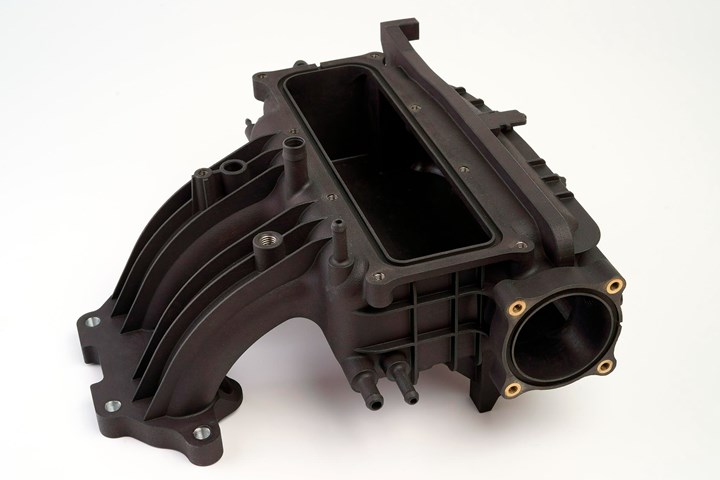CRP Technology celebrates 25 years of 3D printing advancements
Founded in the late 1990s, CRP Technology continues to strive for bold innovation and strong contributions through the evolution of its Windform materials and high-performance electric vehicles.
Share

An intake manifold functional prototype using Windform XP. Photo Credit: CRP Technology
This year CRP Technology (Modena, Italy) celebrates 25 years of 3D printing advancements. The company says it has been familiar with additive manufacturing (AM) since 1996 when Roberto Cevolini, owner of Roberto Cevolini & Co., a high-precision CNC machining avantgarde service, decided to analyze the 3D printing processes with a clear goal in mind: To be able to resolve in advance customers’ issues and offering never-before-seen technological solutions.
As a result, Roberto invested in a sinterstation for selective laser sintering (SLS), which at the time, says CRP Technology, no one had in Italy. In order to make their engineering contribution stronger, Roberto and his son, Franco, founded CRP Technology, a subsidiary of Roberto Cevolini & C.
“My father had a strong drive for bold innovation, a natural predisposition to think beyond that caused him to invent harsh solutions for the most demanding industry sectors,” says Roberto Cevolini’s son, Engineer Franco Cevolini – VP, CTO at CRP Technology.
Upon its founding, CRP Technology also included an R&D department for material development. “Purchasing an industrial 3D printer wasn’t enough for us,” adds Franco. “We wanted to make a major and stronger contribution. So we decided to create a family of 3D-printing materials suitable to manufacture high-performing parts and applications, which could meet the needs of our F1 customers.”
At the end of ‘90s, it become increasingly evident to CRP Technology that SLS was a useful technology with limitations imposed by “process-able” materials limited in scope to use for traditional non-functional prototyping. CRP Technology’s vocation for bold technological innovations developed something out of the ordinary: the Windform range of composite materials for professional 3D printing.
In 1999 Windform, the name born out of its primary purpose as a wind-tunnel material, represented what the company claims is the first hybrid polymer-metal composite (filled with aluminum) to be used for functional prototyping. It proved to satisfy almost all needs for wind-tunnel modeling and allowed aerodynamicists to have a new, powerful tool available in order to make functional, fluid-aerodynamic, fitting and assembling tests. Moreover it proved excellent for direct “in-the racing-car” applications.
Franco Cevolini, who is also the creator of Windform, remembers those years clearly. “Our attitude to create pioneering, high-tech solutions allowed us to be the first to satisfy the most extreme requirements of the F1 industry,” he says. “Windform materials’ high mechanical and thermal properties allowed a shift from the manufacture of simple concept models to high-end prototypes and production parts, thanks to their long-lasting performances, stiffness and light weight.”
While new Windform materials and new high-tech solutions were produced and launched (such as Windform XT, a composite polyamide-based, carbon fiber-filled material for 3D printing) the Cevolini family landed on the U.S. market. In 2008 they founded CRP USA in Mooresville, N.C., the heart of the southern industrial and manufacturing hub surrounded by aerospace and motorsports communities. From that point on, CRP USA started manufacturing on-car and wind tunnel components for racing teams using Windform materials, and has reportedly taken this expertise to new heights to produce parts for the space, entertainment, automotive and other advanced sectors.
In 2015, Windform XT was replaced by Windform XT 2.0, which features improvements in mechanical properties including +8% increase in tensile strength, +22% in tensile modulus and a +46% increase in elongation at break. Windform FR1, a flame-retardant (V-0 rated) material for carbon fiber-reinforced AM, was launched worldwide in 2019, closely followed by Windform FR2, a flame-retardant polyamide-based, glass fiber-filled material. Windform family currently comprises of 12 materials, distributed into two lines, and continues to progress into new sectors.
Further, following their obsession for innovation, the Cevolini family invested in a new field of sustainable vehicles and created Energica (Modena) in 2010, said to be the first high-performance electric motorcycle made in Italy. CRP Technology and CRP Meccanica acted as a technological incubator and are still today the lead investors of Energica Motor Co. since it has become an independent entity.
“We have been working not only to make the change but to be the change,” concludes Franco and Livia Cevolini. “Day by day, we are building the future.”
Related Content
Sulapac introduces Sulapac Flow 1.7 to replace PLA, ABS and PP in FDM, FGF
Available as filament and granules for extrusion, new wood composite matches properties yet is compostable, eliminates microplastics and reduces carbon footprint.
Read MorePlant tour: Albany Engineered Composites, Rochester, N.H., U.S.
Efficient, high-quality, well-controlled composites manufacturing at volume is the mantra for this 3D weaving specialist.
Read MoreA new era for ceramic matrix composites
CMC is expanding, with new fiber production in Europe, faster processes and higher temperature materials enabling applications for industry, hypersonics and New Space.
Read MoreThe potential for thermoplastic composite nacelles
Collins Aerospace draws on global team, decades of experience to demonstrate large, curved AFP and welded structures for the next generation of aircraft.
Read MoreRead Next
All-recycled, needle-punched nonwoven CFRP slashes carbon footprint of Formula 2 seat
Dallara and Tenowo collaborate to produce a race-ready Formula 2 seat using recycled carbon fiber, reducing CO2 emissions by 97.5% compared to virgin materials.
Read More“Structured air” TPS safeguards composite structures
Powered by an 85% air/15% pure polyimide aerogel, Blueshift’s novel material system protects structures during transient thermal events from -200°C to beyond 2400°C for rockets, battery boxes and more.
Read MorePlant tour: Daher Shap’in TechCenter and composites production plant, Saint-Aignan-de-Grandlieu, France
Co-located R&D and production advance OOA thermosets, thermoplastics, welding, recycling and digital technologies for faster processing and certification of lighter, more sustainable composites.
Read More
























